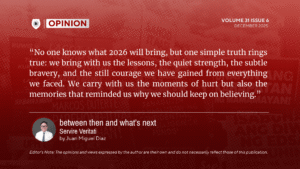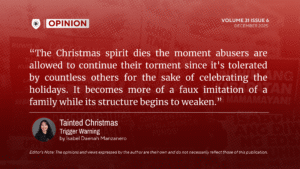Written by Angela Marie B. De Leon | August 26, 2025

Graphic Art by Julianna P. Mondelo
The innocence that we preyed at
MANY years have passed since Senate President Vicente Sotto III proposed a bill to lower the age of criminal responsibility to 13. Once again, the same bill resurfaced in 2025. When it was first proposed, it faced a lot of backlash and criticism, but the continuing question still lies the same: Who is the real culprit?
A week ago, I encountered a Facebook post about a lifeless child who appears to be a victim of an alleged suspect who is also a minor. Attached to it is a caption exclaiming that such an event is the major factor in why lowering the age of criminal liability shall be passed. Most comments are from netizens who agree with the proposed bill of Sen. Robin Padilla, a bill that aims to lower the age of criminal responsibility from 15 to 10. Undeniably, you can’t simply oppose their sentiments, after all, they are parents who go beyond measures to protect their children.
The Bigger Picture
In a report released by the Philippine National Police (PNP) in 2019, the number of crimes committed by ages 13-15 years old is continuously surging, while it is significantly lower for ages 9-11 years old. The majority of these children are coming from the urban poor—is the picture clearer now?
Not everyone is aware, but under our laws, children also face criminal liability. Well, not literally. Under the Republic Act 9344, the Juvenile Justice and Welfare Act of 2006, a child under 15 years old or below is exempt from criminal liability but shall be subject to an intervention program, hoping to reintegrate them once again in society as future contributors in our economy.
With this, you should expect netizens expressing their disappointment about why the law only provides intervention programs? Is that justifiable to the victim, who may also be a child? — I see this as another Filipino hypocrisy, protecting one child at the cost of another. Still, the public is never to blame, but the ones who make and enforce the law should be put to inquest.
Blood is Thicker than Water
Now, let’s take a step back and go back to basics. Erik Erikson, a prominent child psychoanalyst, explained in his Psychoanalytic theory that a child mainly interacts with their parents during the first three stages. In addition to that, Filipino culture emphasizes the strong familial link that a family should have. This shows the significant role that parents play in their child’s development. In our culture, seeing young adults or children still living with their parents is common, some reasons are because of the difficulty of living independently, but most of the time, it is the familial blood that makes these families stick together.
Is this a setback? Not at all, but it might be. In 2023, the Philippine Statistics Authority (PSA) reported that 3 million Filipino families are in poverty. At the individual level, 17.54 million are poor. Imagine being born to a family that forces you to enter survival mode at a young age, not even ripe yet. Instead of being exposed to things a child should be, you are exploited and used as bait for crimes, simply because of your naivety. Some might see you as their hope, but in reality, you might just be a continuation of what they’ve lost.
Today, a large number of children are also victims of child exploitation or trafficking. Most of it involves sexual abuse. Some problems that we also face are child labor, child abuse, child cruelty, etc.
A Damsel in Distress
The proposal of lowering the age of criminal liability is never the solution to the predicaments that our society faces. The government should focus on strengthening the implementation of existing laws. Filling the gaps that the education sector faces, helping families that are misguided and providing opportunity for the less. Such a proposal will only worsen and push us away from the mandate that the supreme law commanded us: to protect the rights of children and to recognize their vital role in nation-building.
Just like in literature, the children are the damsels in distress. Drowning in an endless trope where they are the most vulnerable and a common prey. However, in such a narrative, a certain individual rescues the damsels. But what if the hero that they expect to save them is the same wicked nobleman that causes their demise?
Volume 31 | Issue 2



